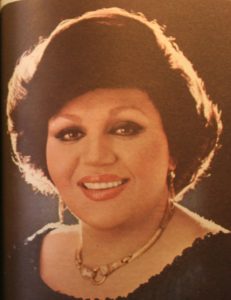HAYEDEH, the iconic singer of 20th century Persia, was born on the 10th April 1942 in Tehran, in an extended family, many of whose members had a good voice. Her real name was Massoumeh Dadehbala.
The voice of Delkash attracted Hayedeh during her adolescence. Ultimately, the poet and lyricist, Rahi Moayyeri, introduced Hayedeh to the legendary songwriter and Persian-style solo violinist Ali Tajvidi, one of the most active of the composers for the Gol-ha [Flowers] Programs on Radio Tehran. “Gol-haa” was a beloved Persian music and poetry program which was created by Davood Prinia in 1956 at the radio. Hayedeh learned to sing accompanied by Tajvidi, and for some time she worked with Farhang Sharif, Ahmad Ebadi, and Fereydoun Nasseri, in the field of Persian vocal music and solfége. Her professional activities began in 1968 with the performance of “Azadeh” [Free], accompanied by the Gol-ha Orchestra on Radio Tehran; Tajvidi’s composition and Rahi Moayyeri’s last lyrics introduced Hayedeh’s voice to the Persian nation.
Tajvidi’s composition and Rahi Moayyeri’s last lyrics introduced Hayedeh’s voice to the Persian nation in 1968.
The onset of Hayedeh’s professional singing career on the Gol-ha radio program and the circumstances of Persian (Iranian) society at the time, the first consequence for Hayedeh was divorce from her husband, Colonel Nouri, and being left alone with her three children.
After the song “Azadeh,” Hayedeh performed almost twelve other works on Radio Tehran composed by Ali Tajvidi, Homayoun Khorram, Ali-Akbar Sheida, and Fereydoun Hafezi, with lyrics written by poets such as Bijan Taraghi, Moeeni Kermanshahi, Navvab Safa, and Parviz Vakili. On two programs, Iraj and Mohammad-Reza Shajarian performed ‘Avaz’ sections. About forty years later, with the efforts of Jane Lewisohn, all these programs were collected and archived in the British Library.
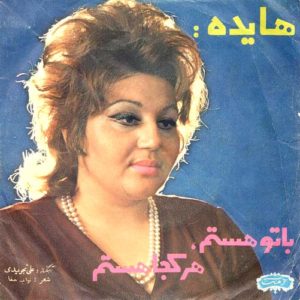
One of Hayedeh’s first LPs in 1969, Released by “Ahang-e Rooz” Records in Tehran
(“Raftam”, Music: A. Tajvidi, Lyrics: E. Navab-Safa)
In the early 1970s, after about three to four years of activity on the Gol-ha program, Hayedeh began to perform more popular songs, collaborating with Fereydoun Khoshnood, Jahanbakhsh Pazouki, Anoushirvan Rohani, and Mohammad Heydari. The artistic value of some of Hayedeh’s songs in this period was gradually and markedly reduced; music and lyrics that were not comparable with her previous works. At times she sang with an Arabian flavor, a style in that in Persia is sometimes called, “semi-traditional,” “cabaret style,” or even “neo-traditional.” This style is heard not only in some of Hayedeh’s songs, but also in many of the songs of her contemporaries who had made the transition from classical to pop, such as Homeyra, Mahasti, and Akbar Golpayegani. Apparently, the atmosphere of the time was conducive to the creation of such songs.
In the same period, Lotfollah Majd, one of the solo tar players on the Gol-ha program of Radio Tehran, told a reporter of “Ettelaat-e Haftegi” magazine: “Among singers who have recently blossomed, I accept only the voice of Hayedeh on the condition that she will work more on classical Persian music.” But despite the love Hayedeh had for her work at the Gol-ha Program, and despite her access to the facilities and to numerous talented soloists and songwriters, Hayedeh did not continue her work on that program. Also the Gol-ha program no longer had the vitality that it had when Hayedeh first joined it; the atmosphere at the radio had changed. During this period, Hayedeh’s performances in the field of classical Persian music consisted of repetitions of past works and the joint performances with Akbar Golpaygani in programs called “Bazm” (Banquet), which were broadcast on the National Iranian Television in the last years before the 1979 revolution.
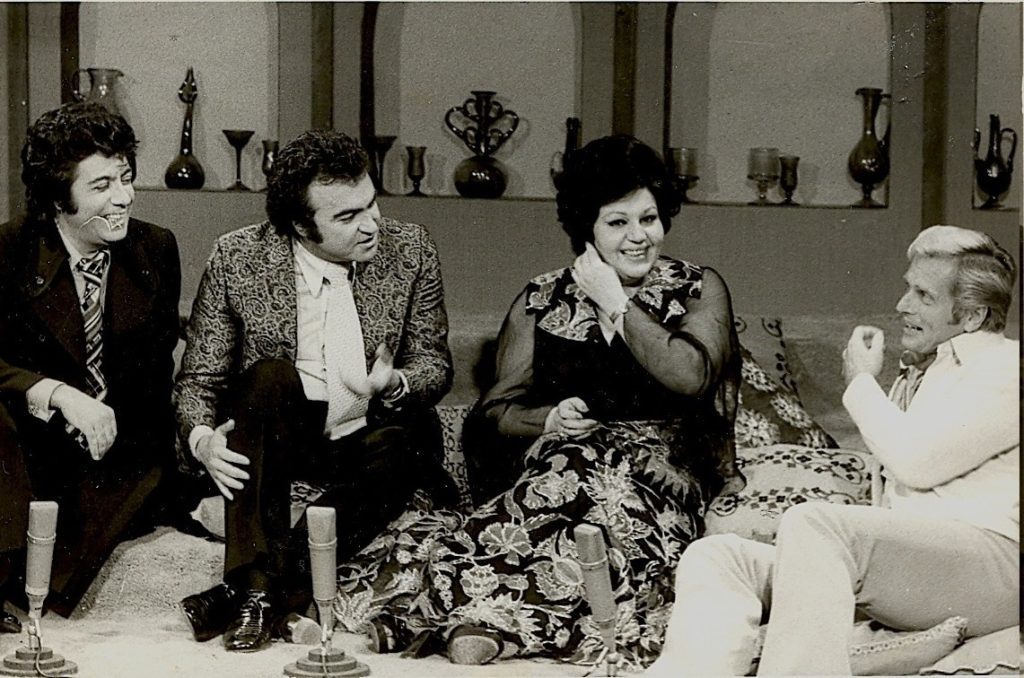
Left to Right: Akbar Golpayegani, Parviz Gharib-Afshar, Hayedeh and an American actor
National TV, Tehran, 1978 © HayedehDocumentary.com
However, in the 1970s, Hayedeh’s popular songs gradually transformed. Collaborations with songwriters and arrangers, who, in addition to having greater knowledge, were more global in form and went beyond the framework of Persian music, added a new dimension to Hayedeh’s career. Songs such as ”Gol-e Sang,” “Soghati” and “Bezan Tar” are from this period.
In this period, Hayedeh’s voice was used in four feature films and also she sang two duet songs with Maziar and Aref. Meanwhile, Hayedeh performed in one of the stories of “A Thousand and One Nights” on Radio Tehran, a program produced and accompanied by Mohsen Farid.
In the 1970s, with the growth of Hayedeh’s activities in the field of popular music, she became a topic of interest in gossip magazines. Stories included her second marriage to a manager of the National Iranian Airlines, Bijan Morad, a marriage that lasted a mere three months, scandalous love affairs with Yadollah Kermanshahi and Manouchehr Khanlari, exorbitant remuneration in cabarets, differences with television coworkers, and rivalry with her sister, Mahasti, which they both usually denied. When she was performing on the Gol-ha program, the magazines would seldom write about her. Now she complained that no one paid attention to her art, just her private life, which was under the microscope.
She was complaining that no one pays attention to her work, just her private life, which was under the microscope.
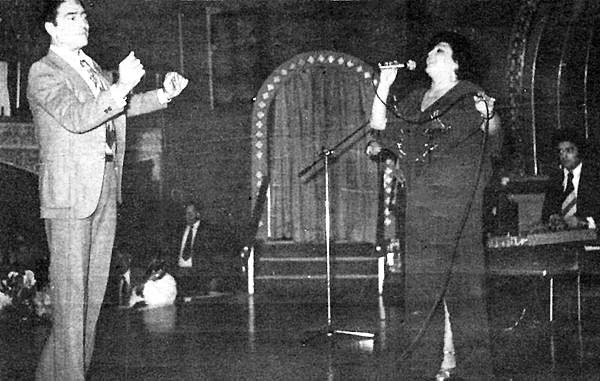
Fardin (actor) and Hayedeh. Tehran, mid-1970s
Hayedeh’s fame gradually went beyond Persia’s borders. She was invited on a private plane to Cannes, France. In a critique of her performance, A. Boussard wrote: “For a French audience, Hayedeh’s character is engulfed in a halo of mystery and secrets – the mystery and secrets of the East. With respect to the strength of her voice, one can only compare her with Caruso. When Frank Sinatra heard her voice, he was overwhelmed and considered it to be magical, although he could not understand the meaning of Hayedeh’s songs…”
In the 1970s, Hayedeh had formed a close connection with the Pahlavi royal court. Along with other singers such as Sattar and Googoosh, she participated in many royal gatherings. In September 1978, a few months before the victory of a revolution which prohibited female singing and restricted Persian musical life, Hayedeh left Tehran for London. Until her death, the memory of this journey remained the bitterest of her life.In 1979, the Revolutionary Court in Tehran summoned Hayedeh along with other singers and film stars such as Googoosh, Homeyra, and Fereydoun Farrokhzad. The summons was published in Tehran’s Kayhan newspaper.
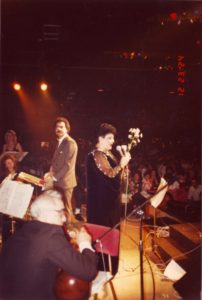
In 1978, a few months before the victory of a revolution which prohibited female singing and restricted Persian musical life, Hayedeh left Tehran for London.
After the revolution, Hayedeh spent about three years with her children, Keyvan, Kamran, and Noushin in London. She performed a number of concerts along with Persian musicians. “Mizanam Faryad” [Scream, I will], with lyrics by Karim Fakoor, and music by Anoushirvan Rohani, was one of the first songs she performed in the loneliness of exile. It was always requested by Persians who had fled the revolution and the war.
In 1982, with the concentration of Persian immigrants, especially singers and performers, in Southern California, Hayedeh left London for Los Angeles. One of her first formal performances in LA was a concert at UCLA, that she performed with a Persian instruments ensemble under the supervision of Manouchehr Sadeghi as part of a Society for Ethnomusicology conference. Many reputable Persian musicians residing in California were present at this concert. However, not enough balance between them could be heard.
In Los Angeles, Hayedeh’s activities on the stage were mostly at the Tehran Cabaret, under the management of Ahmad Massoud. The cabaret was located on the outskirts of the city. It became a gathering place for many Persian immigrants in Los Angeles during the 1979 hostage taking at U.S. embassy in Tehran that led to an anti-Iranian atmosphere in the United States.
The onset of the eight-year Iran-Iraq war, the unprecedented fleeing of Persians from their country, and Hayedeh’s powerful and influential performances of songs in which one could hear the waves of bitterness and sorrow of having to forsake Persia combined to make Hayedeh more popular than ever.
Within a short period, with the help of talented songwriters, lyricists and arrangers, Hayedeh’s performances in this city led one of her most successful artistic periods. The onset of the eight-year Iran-Iraq war, the unprecedented fleeing of Persians from their country, and Hayedeh’s powerful and influential performances of songs in which one could hear the waves of bitterness and sorrow of having to forsake Persia, written by songwriters such as Farid Zoland, Mohammad Heydari, Sadegh Nojouki and Andranik, and with lyrics by Ardalan Sarafraz, Bijan Samandar, and Leila Kasra (Hedieh), among others, … combined to make Hayedeh more popular than ever. Songs such as “Zahr-e Jodaie” [The Poison of Separation], “Bahar Bahar Baaz Oumade“ [Spring, Spring is Here Again], and “Rouzaye Roshan Khodahafez” [Goodbye Bright Days] are among the memories of Hayedeh’s works in that period.

Left to right: Morteza, Goli Yahyavi, Sattar, Hayedeh, Farid Zoland, Mahasti
Los Angeles, Persian New Year Show, 1984
Los Angeles, Persian New Year Show, 1984
In addition to these songs, which exerted a strong influence both on Persians who had fled the revolution and the war and on those who had remained in their homeland, up-beat dance songs such as “Ravi”, “Narges-e Shiraz”, and “Shab-e Eshgh”, attracted a larger segment of the population, especially among the youth. Many of these songs presented new forms of singing from her, and even though at times they seemed distant from Persian music, Hayedeh’s voice and style of performance imparted a Persian flavor to them.
In this period, Hayedeh developed a strong inclination for the lyrics by Leila Kasra (Hedieh), a lyricist who gradually became one of Hayedeh’s closest friends. Hedieh, who became severely ill, died a few months before Hayedeh.
In Los Angeles, success for Hayedeh was not free of difficulties and headaches. She complained of rumors that the media created for her. She said that life and work in that city required nerves of steel. Given the influence of Persian Jews in Southern California and their significant support for artistic events, one of the most damaging rumors concerning Hayedeh, was that at one concert she expressed approval for the burning of Jews during World War II. The rumor was never proven, but some interpreted Hayedeh’s concert at a Tel Aviv stadium as an effort to dispel it.
During Nowrouz (Persian New Year) 1365 (March 1986), at the zenith of her professional career, Hayedeh left for London to participate in a concert at the Royal Albert Hall – a concert organized by Aris Gasparian, and accompanied by the large orchestra conducted by Farnoosh Behzad. This was one of the first major Persian concerts organized abroad during the post-revolutionary years. Sattar and Morteza also participated. As with many of the Persian emigrants in the 1980s, Hayedeh was under the illusion that she would soon return to Persia.
In 1986 at the zenith of her professional career, Hayedeh participated in a concert at the Royal Albert Hall. This was one of the first major Persian concerts organized abroad during the post-revolutionary years.
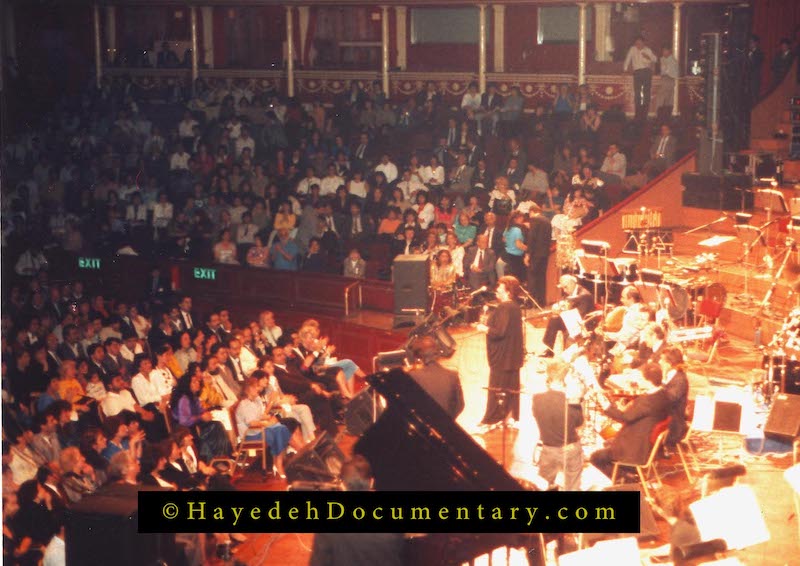
Hayedeh, Royal Albert Hall, London, 1987 © HayedehDocumentary.com
Among Hayedeh’s other performances in Europe, excluding semi-formal programs in Persian circles, there were concerts at the Musikhalle Hamburg and Hammersmith Palais in London.
In Los Angeles, most of Hayedeh’s television programs were concentrated in the Jam-e Jam Television network, which was established in 1981 with the efforts of Manuchehr Bibiyan and IR TV, found by Ali Limonadi in the same year. Tens of music videos of Hayedeh were recorded at these stations and also at Iran’s the National Movement (Jonbesh-e Melli) TV station. As was the case with other videos produced during that period, most of these music videos moved illegally from hand to hand in Iran.Ever since adolescence, Hayedeh was afflicted with diabetes, and in later years, high blood pressure and heart trouble were added. Disregard for her physical health, over-consumption of alcohol, the pressures that bore on her heart due to her singing, and her depression on account of being away from her own country… perhaps these all conspired to cause her premature death.
During the last months of her life she was planning another marriage. In her last interview with Mehdi Zakai in Javanan magazine published in Los Angeles, she said that she had a renewed spirit; that she wanted to expand her activities and concentrate her energy on gala events; and that she was also recording a new album for Nowrouz ‘69 (March 1990), which included only joyful and love songs. However, she did not have the opportunity to finish this album. “Ye Rouz” [One Day], and “Asheghtarin” [Most in Love], two songs written by Hossein Vaseghi, which in terms of quality represented a substantial drop in her work, are among her last pieces.
On the last night of her life, January 19, 1990, Hayedeh performed at the Casablanca club in a San Francisco suburb. In spite of her ailing physical condition, she gave one of her most memorable performances that night, accompanied by musicians such as Parviz Rahman-Panah and Abdi Yamini. Hayedeh’s three-hour program at the Casablanca club was filmed with a hand-held camera by Khosrow Motarjemi – a film which has yet to be released. The next day, on January 20, 1990, Hayedeh died from a heart attack at the age of 47.
On January 20, 1990, Hayedeh died from a heart attack at the age of 47.
ÂÂ 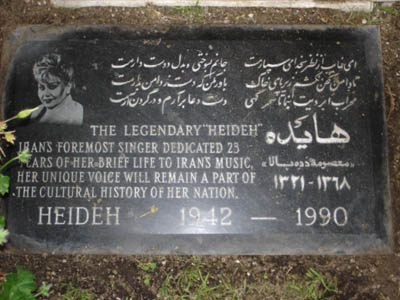

Gravestone of Hayedeh, Westwood Cemetery
(Photo by Arash Behtash / © HayedehDocumentary.com)
(Photo by Arash Behtash / © HayedehDocumentary.com)
The fruits of about 21 years of Hayedeh’s activities amount to about 150 songs and avaz, nearly all of which have been re-released in the form of CDs by companies such as Taraneh, Caltex, Pars Video and MZM in the United States. Nevertheless, the tapes and videos of some of her songs have been forgotten, gathering dust in music companies and television archives.
SEE ALSO:
L.A. City Council Honors Persian Singer Hayedeh
Hayedeh’s relatives, coworkers, and friends have thus far not seriously acted upon gathering and releasing her scattered works. Years ago, with the efforts of Mohammad Heidari and Sattar, an institution by the name of “Hayedeh Memorial Foundation” released two albums entitled, “The Nightingale that Burned Out,” and “The Unheard,” which include Hayedeh’s performances in private circles, but after a short while this foundation disappeared. However, in reality, it was nothing more than a name.
Nevertheless, in Hayedeh’s birthplace, it is still not possible to speak of her. In the Third Millennium, the employment of a Metro engine driver in Tehran was suspended for playing the song of a “monarchist singer;” in addition, the name of this singer is erased from most books on music in Iran, and one does not dare utter her name in the media.
In the years that have passed since Hayedeh’s fading light, alongside the innumerable governmental restrictions, her songs still enchant an untold number of Persians of different generations.
Nevertheless, in the years that have passed since Hayedeh’s fading light, alongside the innumerable governmental restrictions, her songs still enchant an untold number of Persians of different generations. Her fans, both inside and outside of Persia, have uploaded samples of her works on the Internet and have written of her memory on blogs. Some time ago, I found a short post on one of these blogs: “The feeling that Hayedeh’s voice evokes is that of losing whatever one has loved, namely, Hayedeh herself…”
Making a documentary about Hayedeh for me was not just making a documentary about a beloved singer; it was something about my country, my memories and what we lost in the past years…

The Documentary film “HAYEDEH: LEGENDARY PERSIAN DIVA” is available on DVD :
Join The Facebook Page of “Hayedeh: Legendary Persian Diva” Documentary Project
